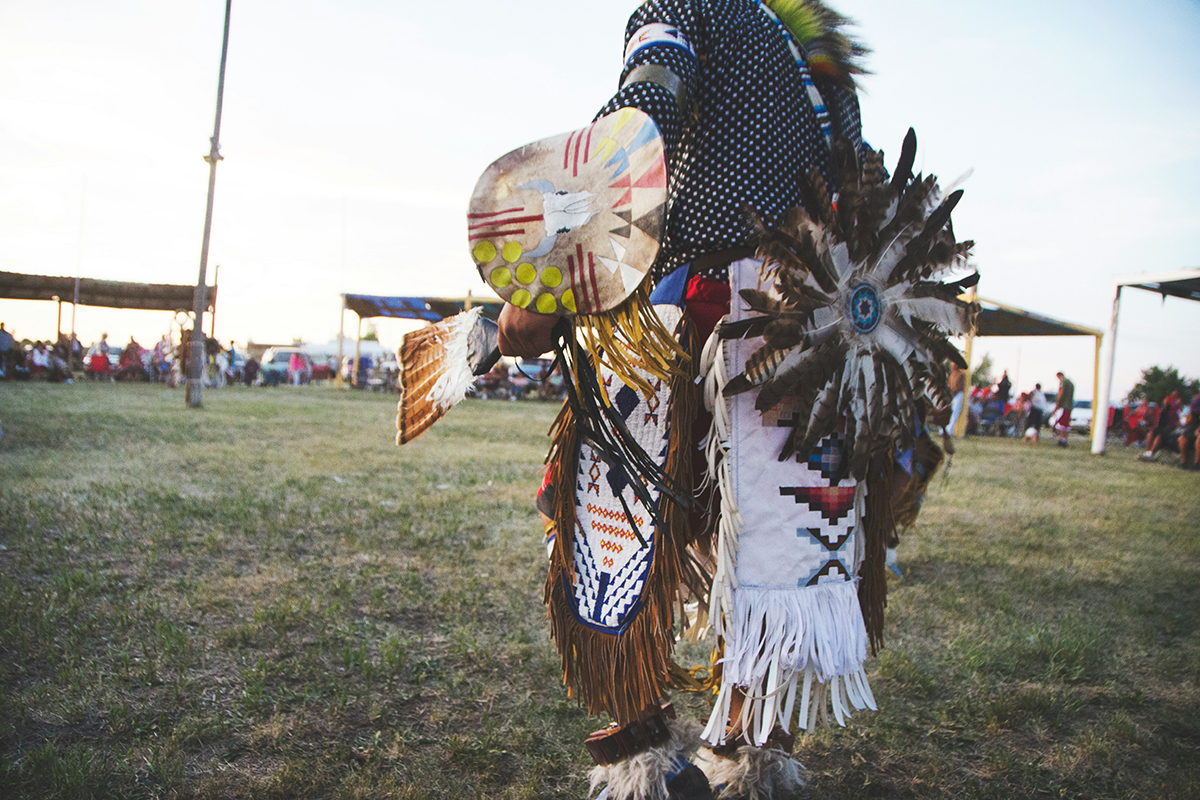
This November, the Diversity Book Display's theme will be Indigenous Americas. This term refers to those who inhabited the Americas before European colonization in the 15th century.
Though many simplistic or homogenous stereotypes exist of what Indigenous peoples and cultures were and are like today, the reality is much more complex. For example, there are roughly 70 million people today who identify as Indigenous, over 1000 languages are recognized and spoken by those identifying as Indigenous.
Check out this month's selection of books to learn more about the wide diversity of the histories, cultures and languages experienced by peoples and groups who identify as Indigenous peoples.
A physical book display is now available at Hunt Library with the selection rotating weekly. Some of the eBooks listed below also have a physical listing. Please check the availability.
Special thanks to our Materials Processing Coordinator, Leah Zande, for compiling this list. Learn more on the DEI events page. Feature image by Jess Lindner on Unsplash.
Music and Modernity Among First Peoples of North America
Robinson, Dylan; Levine, Victoria Lindsay (2019)
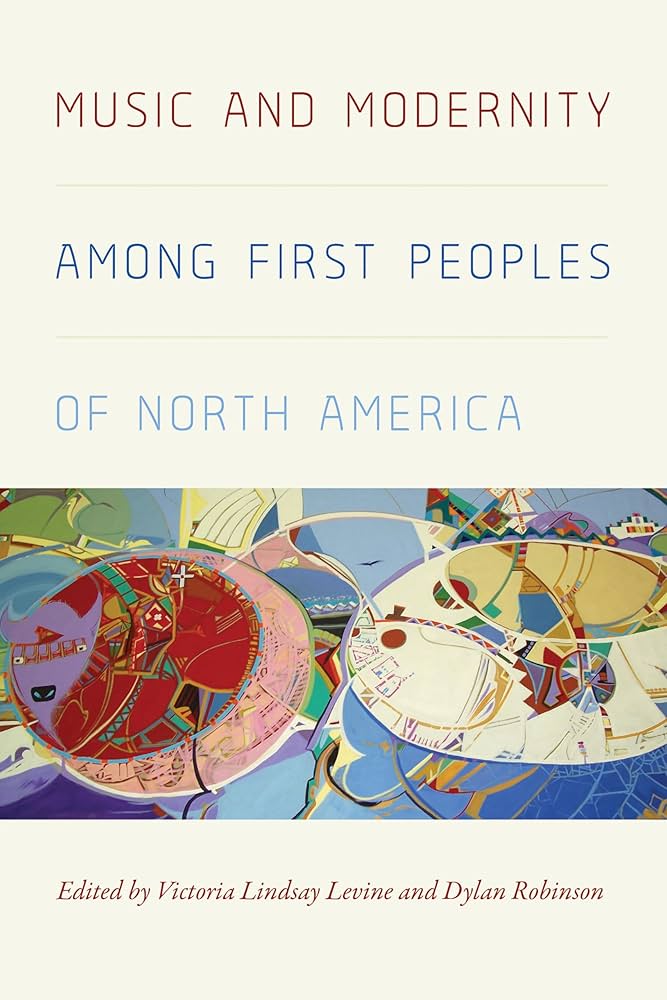 "Music and Modernity among First Peoples of North America" is a collaboration between Indigenous and settler scholars from both Canada and the United States. The contributors explore the intersections between music, modernity, and Indigeneity in essays addressing topics that range from hip-hop to powwow, and television soundtracks of Native Classical and experimental music. Working from the shared premise that multiple modernities exist for Indigenous peoples, the authors seek to understand contemporary musical expression from Native perspectives and to decolonize the study of Native American/First Nations music.
"Music and Modernity among First Peoples of North America" is a collaboration between Indigenous and settler scholars from both Canada and the United States. The contributors explore the intersections between music, modernity, and Indigeneity in essays addressing topics that range from hip-hop to powwow, and television soundtracks of Native Classical and experimental music. Working from the shared premise that multiple modernities exist for Indigenous peoples, the authors seek to understand contemporary musical expression from Native perspectives and to decolonize the study of Native American/First Nations music.
The essays coalesce around four main themes: innovative technology, identity formation and self-representation, political activism, and translocal musical exchange. Closely related topics include cosmopolitanism, hybridity, alliance studies, code-switching, and ontologies of sound. Featuring the work of both established and emerging scholars, the collection demonstrates the centrality of music in communicating the complex, diverse lived experience of Indigenous North Americans in the twenty-first century and brings ethnomusicology into dialogue with critical Indigenous studies. - Publisher's Description
Request this Title
Inca Music Reimagined: Indigenist Discourses in Latin American Art Music, 1910-1930
Wolkowicz, Vera (2022)
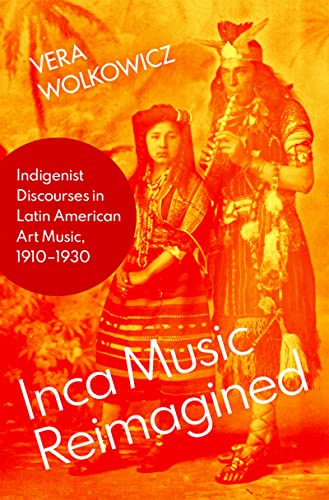 The Latin American centennial celebrations of independence (ca.1909-1925) constituted a key moment in the consolidation of national symbols and emblems, while also producing a renewed focus on transnational affinities that generated a series of discourses about continental unity. At the same time, a boom in archaeological explorations, within a general climate of scientific positivism provided Latin Americans with new information about their "grandiose" former civilizations, such as the Inca and the Aztec, which some argued were comparable to ancient Greek and Egyptian cultures. These discourses were at first political, before transitioning to the cultural sphere. As a result, artists and particularly musicians began to move away from European techniques and themes, to produce a distinctive and self-consciously Latin American art.
The Latin American centennial celebrations of independence (ca.1909-1925) constituted a key moment in the consolidation of national symbols and emblems, while also producing a renewed focus on transnational affinities that generated a series of discourses about continental unity. At the same time, a boom in archaeological explorations, within a general climate of scientific positivism provided Latin Americans with new information about their "grandiose" former civilizations, such as the Inca and the Aztec, which some argued were comparable to ancient Greek and Egyptian cultures. These discourses were at first political, before transitioning to the cultural sphere. As a result, artists and particularly musicians began to move away from European techniques and themes, to produce a distinctive and self-consciously Latin American art.
In "Inca Music Reimagined" author Vera Wolkowicz explores Inca discourses in particular as a source for the creation of "national" and "continental" art music during the first decades of the twentieth century, concentrating on operas by composers from Peru, Ecuador and Argentina. To understand this process, Wolkowicz analyzes early twentieth-century writings on Inca music and its origins and describes how certain composers transposed "Inca" techniques into their own works, and how this music was perceived by local audiences. Ultimately, she argues that the turn to Inca culture and music in the hopes of constructing a sense of national unity could only succeed within particular intellectual circles, and that the idea that the inspiration of the Inca could produce a "music of America" would remain utopian. - Publisher's Description
Request this Title
Adjusting the Lens: Indigenous Activism, Colonial Legacies, and Photographic Heritage
Lien, Sigrid; Nielssen, Hilde Wallem (2021)
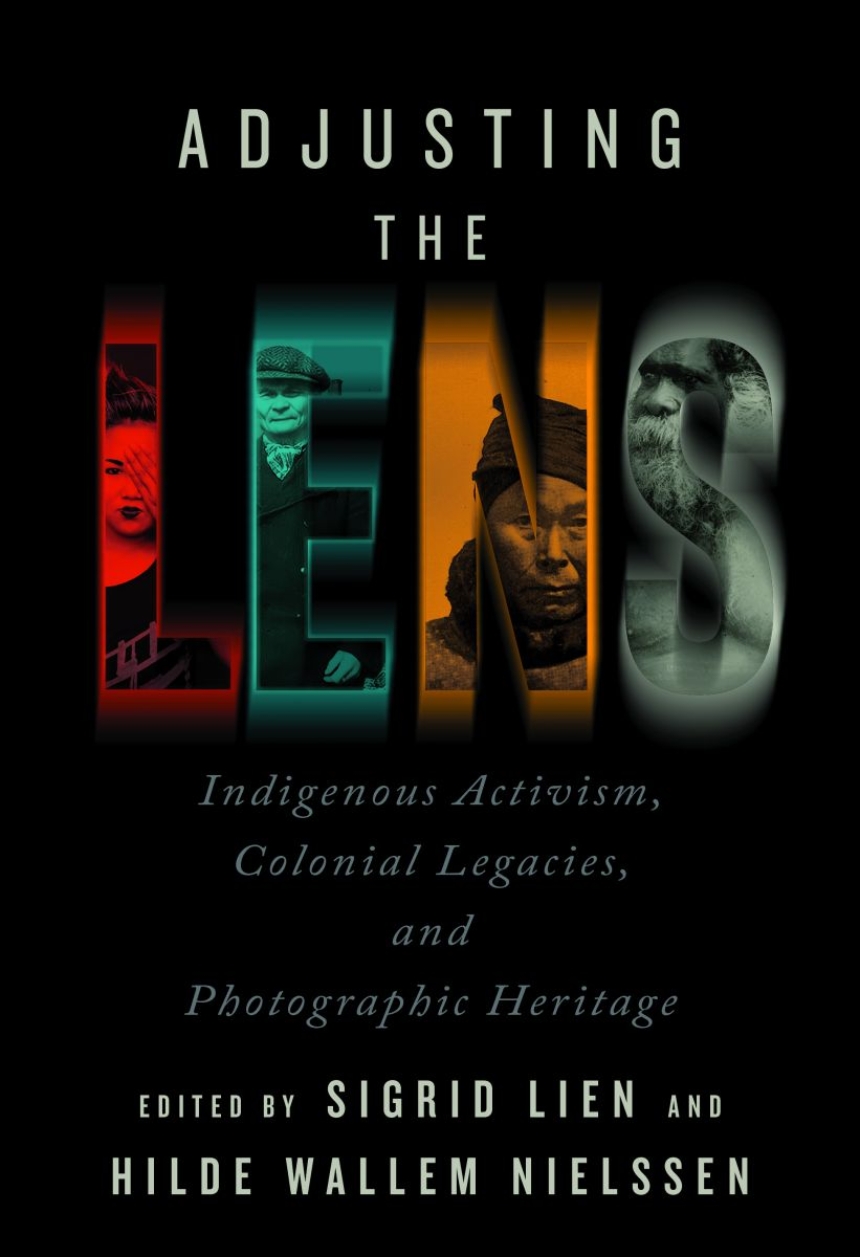 Apparently neutral windows into the past, colonial photographs lie at the center of Indigenous art activism across the globe. Through a series of moving case studies, "Adjusting the Lens" explores how Indigenous artists in Australia, Canada, Finland, Greenland, Norway, and the United States today confront and redevelop this archive as they strive to empower and revitalize their communities and decolonize the historical record. - Publisher's Description
Apparently neutral windows into the past, colonial photographs lie at the center of Indigenous art activism across the globe. Through a series of moving case studies, "Adjusting the Lens" explores how Indigenous artists in Australia, Canada, Finland, Greenland, Norway, and the United States today confront and redevelop this archive as they strive to empower and revitalize their communities and decolonize the historical record. - Publisher's Description
Request this Title
Unseen Art: Making, Vision, and Power in Ancient Mesoamerica
Brittenham, Claudia (2023)
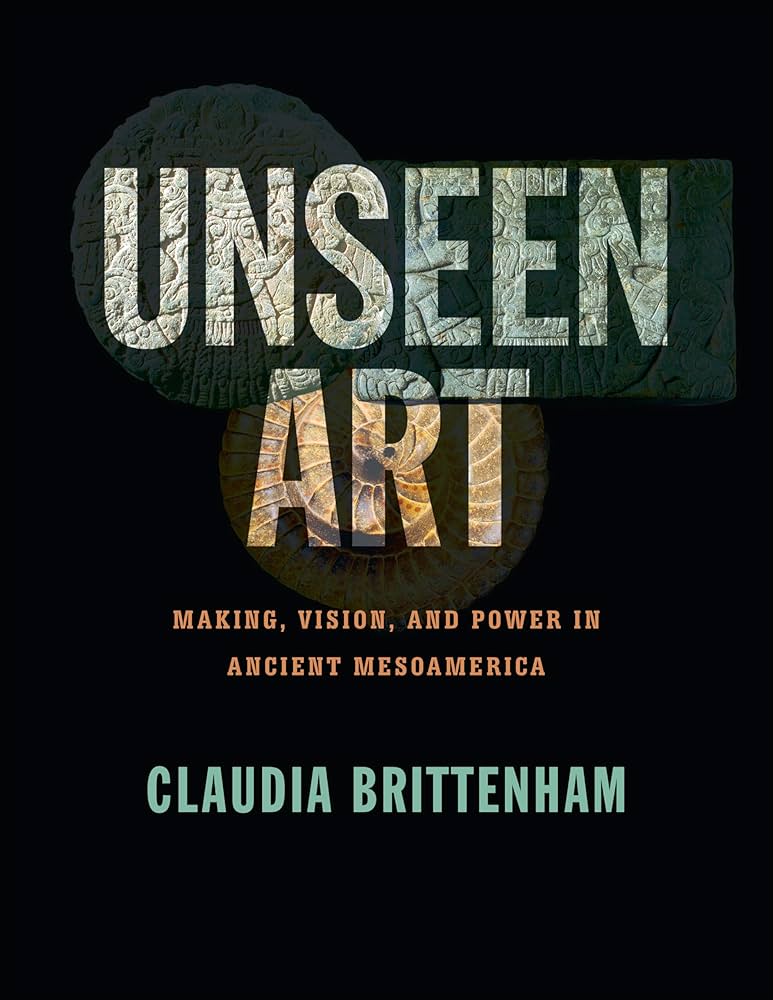 In "Unseen Art," Claudia Brittenham unravels one of the most puzzling phenomena in Mesoamerican art history: why many of the objects that we view in museums today were once so difficult to see. She examines the importance that ancient Mesoamerican people assigned to the process of making and enlivening the things we now call art, as well as Mesoamerican understandings of sight as an especially godlike and elite power, in order to trace a gradual evolution in the uses of secrecy and concealment, from a communal practice that fostered social memory to a tool of imperial power.
In "Unseen Art," Claudia Brittenham unravels one of the most puzzling phenomena in Mesoamerican art history: why many of the objects that we view in museums today were once so difficult to see. She examines the importance that ancient Mesoamerican people assigned to the process of making and enlivening the things we now call art, as well as Mesoamerican understandings of sight as an especially godlike and elite power, in order to trace a gradual evolution in the uses of secrecy and concealment, from a communal practice that fostered social memory to a tool of imperial power.
Addressing some of the most charismatic of all Mesoamerican sculptures, such as Olmec buried offerings, Maya lintels, and carvings on the undersides of Aztec sculptures, Brittenham shows that the creation of unseen art has important implications both for understanding status in ancient Mesoamerica and for analyzing art in the present. Spanning nearly three thousand years of the Indigenous art of Mexico, Guatemala, Honduras, and Belize, "Unseen Art" connects the dots between vision, power, and inequality, providing a critical perspective on our own way of looking. - Publisher's Description
Request this Title
The Art of Ceremony: Voices of Renewal from Indigenous Oregon
Dobkins, Rebecca (2022)
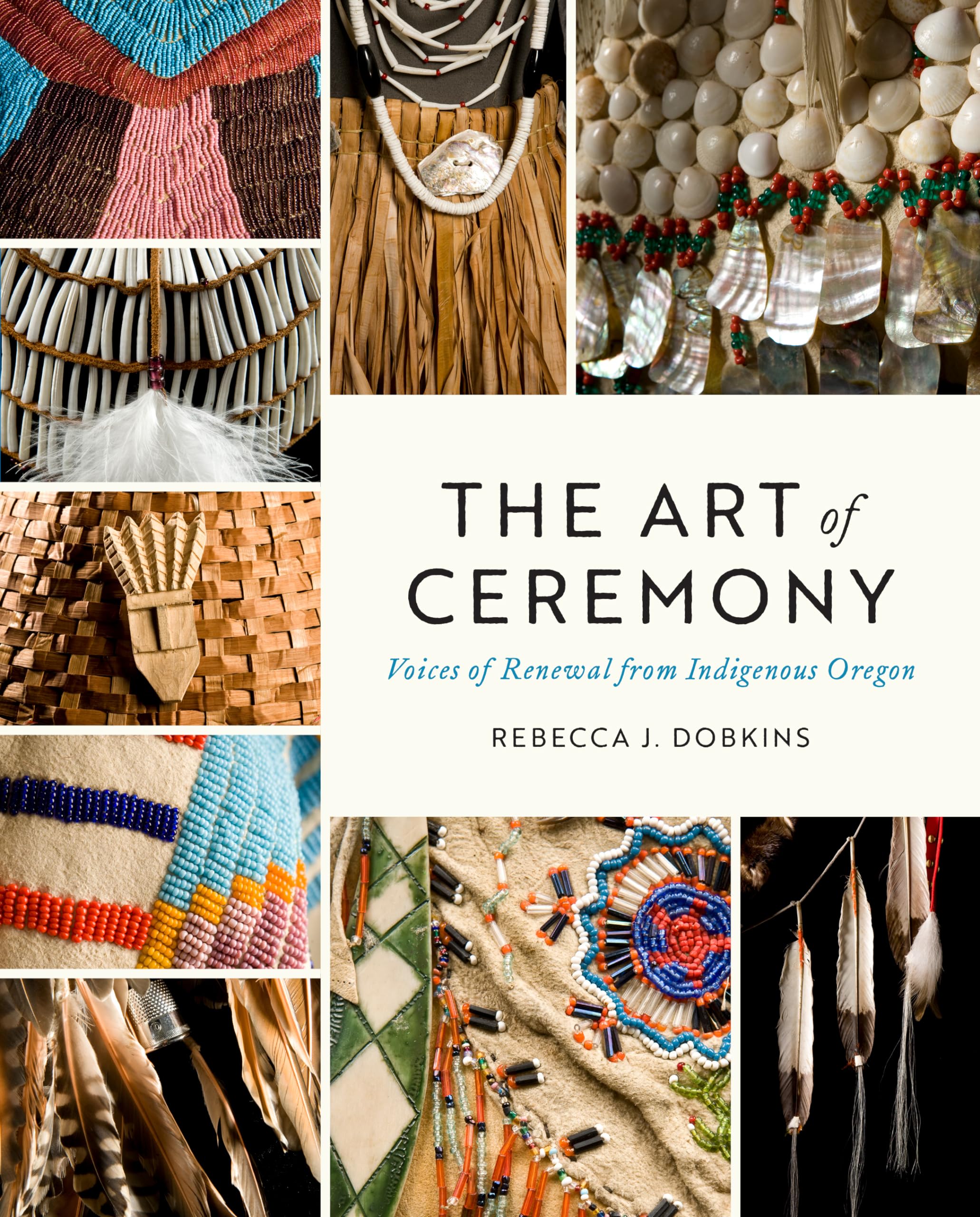 The practice of ceremony offers ways to build relationships between the land and its beings, reflecting change while drawing upon deep relationships going back millennia. Ceremony may involve intricate and spectacular regalia but may also involve simple tools, such as a plastic bucket for harvesting huckleberries or a river rock that holds heat for sweat. "The Art of Ceremony" provides a contemporary and historical overview of the nine federally recognized tribes in Oregon, through rich conversations with tribal representatives who convey their commitments to ceremonial practices and the inseparable need to renew language, art, ecological systems, kinship relations, and political and legal sovereignty.
The practice of ceremony offers ways to build relationships between the land and its beings, reflecting change while drawing upon deep relationships going back millennia. Ceremony may involve intricate and spectacular regalia but may also involve simple tools, such as a plastic bucket for harvesting huckleberries or a river rock that holds heat for sweat. "The Art of Ceremony" provides a contemporary and historical overview of the nine federally recognized tribes in Oregon, through rich conversations with tribal representatives who convey their commitments to ceremonial practices and the inseparable need to renew language, art, ecological systems, kinship relations, and political and legal sovereignty.
Vivid photographs illuminate the ties between land and people at the heart of such practice, and each chapter features specific ceremonies chosen by tribal co-collaborators, such as the Siletz Nee Dosh (Feather Dance), the huckleberry gathering of the Cow Creek Umpqua, and the Klamath Return of C'waam (sucker fish) Ceremony. Part of a larger global story of Indigenous rights and cultural resurgence in the twenty-first century, "The Art of Ceremony" celebrates the power of Indigenous renewal, sustainable connection to the land, and the ethics of responsibility and reciprocity between the earth and all its inhabitants. - Publisher's Description
Request this Title
Living with Nature, Cherishing Language: Indigenous Knowledges in the Americas Through History
Olko, Justyna; Radding, Cynthia (2024)
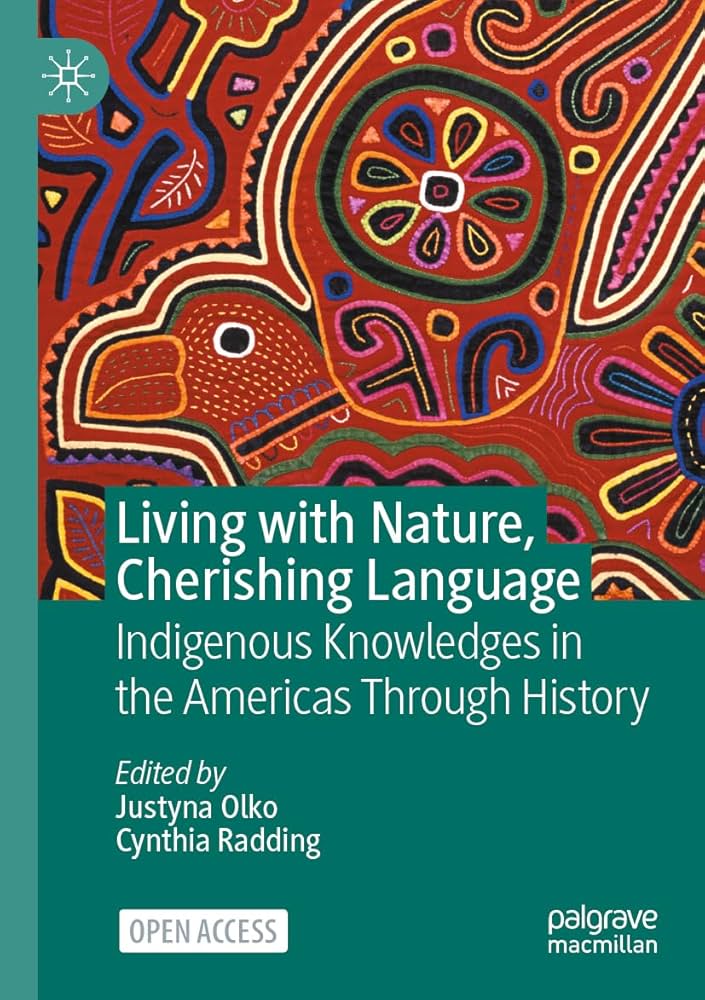 This open access book explores the deep connections between environment, language, and cultural integrity, with a focus on Indigenous peoples from early modern times to the present. It illustrates the close integration of nature and culture through historical processes of environmental change in North, Central, and South America and the nurturing of local knowledge through ancestral languages and oral traditions.
This open access book explores the deep connections between environment, language, and cultural integrity, with a focus on Indigenous peoples from early modern times to the present. It illustrates the close integration of nature and culture through historical processes of environmental change in North, Central, and South America and the nurturing of local knowledge through ancestral languages and oral traditions.
This volume fills a unique space by bringing together the issues of environment, language and cultural integrity in Latin American historical and cultural spheres. It explores the reciprocal and necessary relations between language/culture and environment; how they can lead to sustainable practices; how environmental knowledge and sustainable practices toward the environment are reflected in local languages, local sources and local socio-cultural practices. The book combines interdisciplinary methods and initiates a dialogue among scientifically trained scholars and local communities to compare their perspectives on well-being in remote and recent historical periods and it will be of interest to students and scholars in fields including sociolinguistics, (ethno)history, linguistic anthropology, cultural studies and cultural anthropology, environmental studies and Indigenous/minority studies. - Publisher's Description
Request this Title
A Drum in One Hand, a Sockeye in the Other: Stories of Indigenous Food Sovereignty from the Northwest Coast
Cote, Charlotte (2022)
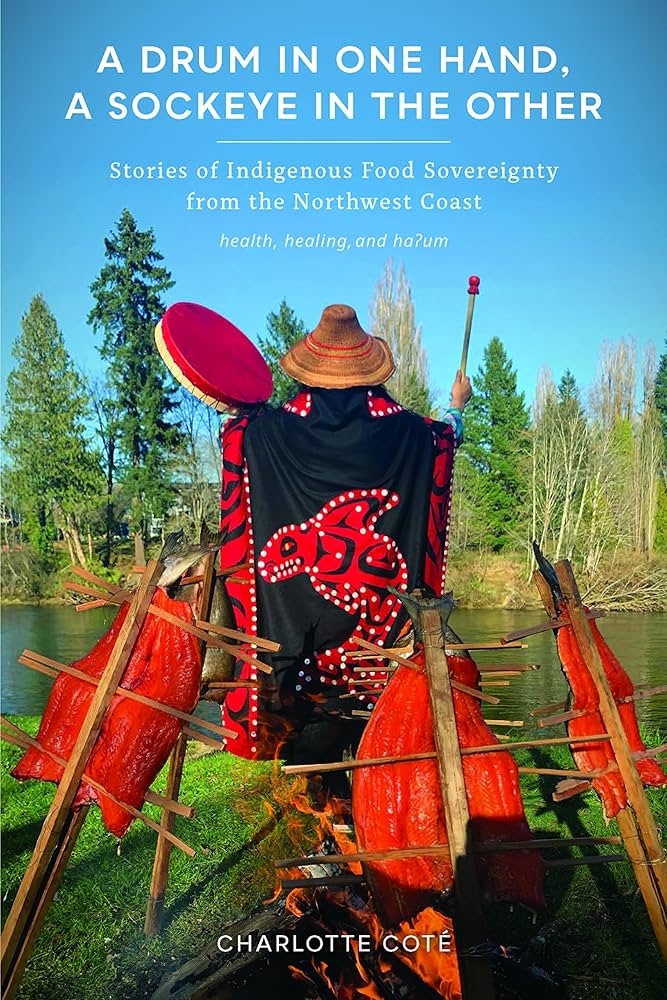 In the dense rainforest of the west coast of Vancouver Island, the Somass River (uumaas) brings sockeye salmon (miaat) into the Nuu-chah-nulth community of Tseshaht. uumaas and miaat are central to the sacred food practices that have been a crucial part of the Indigenous community's efforts to enact food sovereignty, decolonize their diet, and preserve their ancestral knowledge.
In the dense rainforest of the west coast of Vancouver Island, the Somass River (uumaas) brings sockeye salmon (miaat) into the Nuu-chah-nulth community of Tseshaht. uumaas and miaat are central to the sacred food practices that have been a crucial part of the Indigenous community's efforts to enact food sovereignty, decolonize their diet, and preserve their ancestral knowledge.
In "A Drum in One Hand, a Sockeye in the Other," Charlotte Coté shares contemporary Nuu-chah-nulth practices of traditional food revitalization in the context of broader efforts to re-Indigenize contemporary diets on the Northwest Coast. Coté offers evocative stories of her Tseshaht community's and her own work to revitalize relationships to haʔum (traditional food) as a way to nurture health and wellness. As Indigenous peoples continue to face food insecurity due to ongoing inequality, environmental degradation, and the Westernization of traditional diets, Coté foregrounds healing and cultural sustenance via everyday enactments of food sovereignty: berry picking, salmon fishing, and building a community garden on reclaimed residential school grounds. This book is for everyone concerned about the major role food plays in physical, emotional, and spiritual wellness. - Publisher's Description
Request this Title
Gender and Sexuality in Indigenous North America, 1400-1850
Yarbrough, Fay; Slater, Sandra (2022)
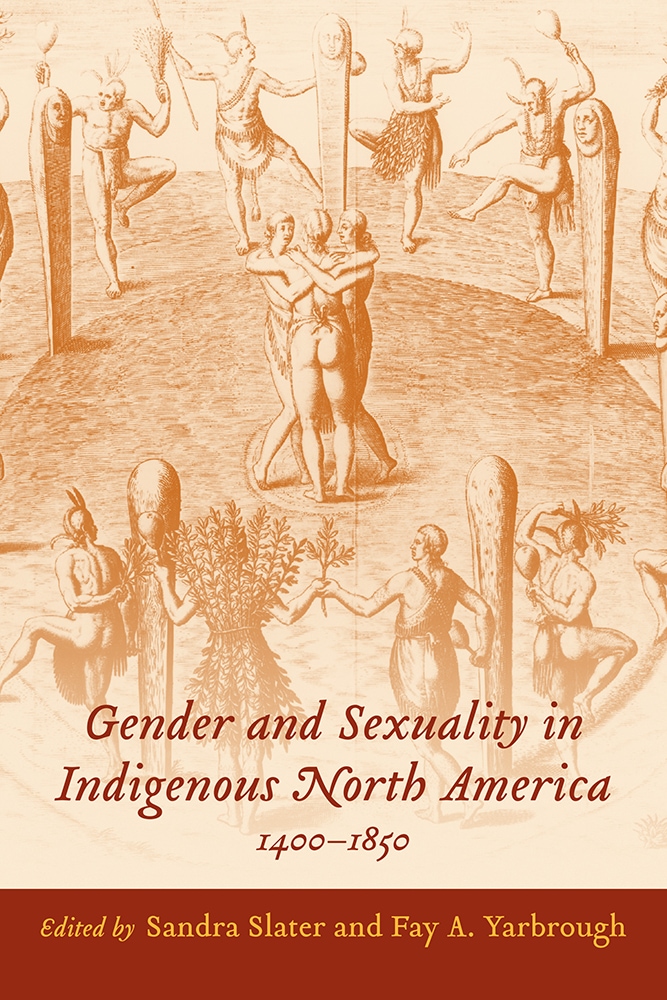 Prior to the arrival of Europeans in the New World, Native Americans across the continent had developed richly complex attitudes and forms of expression concerning gender and sexual roles. The role of the "berdache," a man living as a woman or a woman living as a man in native societies, has received recent scholarly attention but represents just one of many such occurrences of alternative gender identification in these cultures. Editors Sandra Slater and Fay A. Yarbrough have brought together scholars who explore the historical implications of these variations in the meanings of gender, sexuality, and marriage among indigenous communities in North America. Essays that span from the colonial period through the nineteenth century illustrate how these aspects of Native American life were altered through interactions with Europeans.
Prior to the arrival of Europeans in the New World, Native Americans across the continent had developed richly complex attitudes and forms of expression concerning gender and sexual roles. The role of the "berdache," a man living as a woman or a woman living as a man in native societies, has received recent scholarly attention but represents just one of many such occurrences of alternative gender identification in these cultures. Editors Sandra Slater and Fay A. Yarbrough have brought together scholars who explore the historical implications of these variations in the meanings of gender, sexuality, and marriage among indigenous communities in North America. Essays that span from the colonial period through the nineteenth century illustrate how these aspects of Native American life were altered through interactions with Europeans.
Organized chronologically, "Gender and Sexuality in Indigenous North America, 1400–1850" probes gender identification, labor roles, and political authority within Native American societies. The essays are linked by overarching examinations of how Europeans manipulated native ideas about gender for their own ends and how indigenous people responded to European attempts to impose gendered cultural practices at odds with established traditions. Many of the essays also address how indigenous people made meaning of gender and how these meanings developed over time within their own communities. Several contributors also consider sexual practice as a mode of cultural articulation, as well as a vehicle for the expression of gender roles.
Representing groundbreaking scholarship in the field of Native American studies, these insightful discussions of gender, sexuality, and identity advance our understanding of cultural traditions and clashes that continue to resonate in native communities today as well as in the larger societies those communities exist within. - Publisher's Description
Request this Title
Rural Indigenousness: A History of Iroquoian and Algonquian Peoples of the Adirondacks
Otis, Melissa (2018)
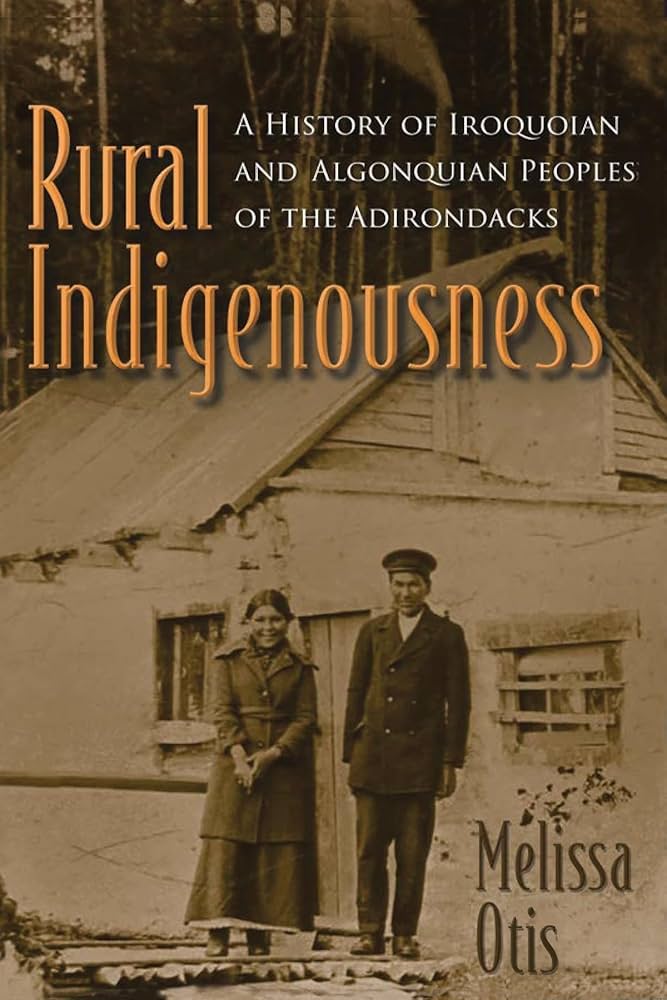 The Adirondacks have been an Indigenous homeland for millennia, and the presence of Native people in the region was obvious but not well documented by Europeans, who did not venture into the interior between the seventeenth and early nineteenth centuries. Yet, by the late nineteenth century, historians had scarcely any record of their long-lasting and vibrant existence in the area.
The Adirondacks have been an Indigenous homeland for millennia, and the presence of Native people in the region was obvious but not well documented by Europeans, who did not venture into the interior between the seventeenth and early nineteenth centuries. Yet, by the late nineteenth century, historians had scarcely any record of their long-lasting and vibrant existence in the area.
With "Rural Indigenousness," Otis shines a light on the rich history of Algonquian and Iroquoian people, offering the first comprehensive study of the relationship between Native Americans and the Adirondacks. While Otis focuses on the nineteenth century, she extends her analysis to periods before and after this era, revealing both the continuity and change that characterize the relationship over time. Otis argues that the landscape was much more than a mere hunting ground for Native residents; rather, it a “location of exchange,” a space of interaction where the land was woven into the fabric of their lives as an essential source of refuge and survival. Drawing upon archival research, material culture, and oral histories, Otis examines the nature of Indigenous populations living in predominantly Euroamerican communities to identify the ways in which some maintained their distinct identity while also making selective adaptations exemplifying the concept of “survivance.” In doing so, "Rural Indigenousness" develops a new conversation in the field of Native American studies that expands our understanding of urban and rural indigeneity. - Publisher's Description
Request this Title
Firsting in the Early-modern Atlantic World
Beck, Lauren (2020)
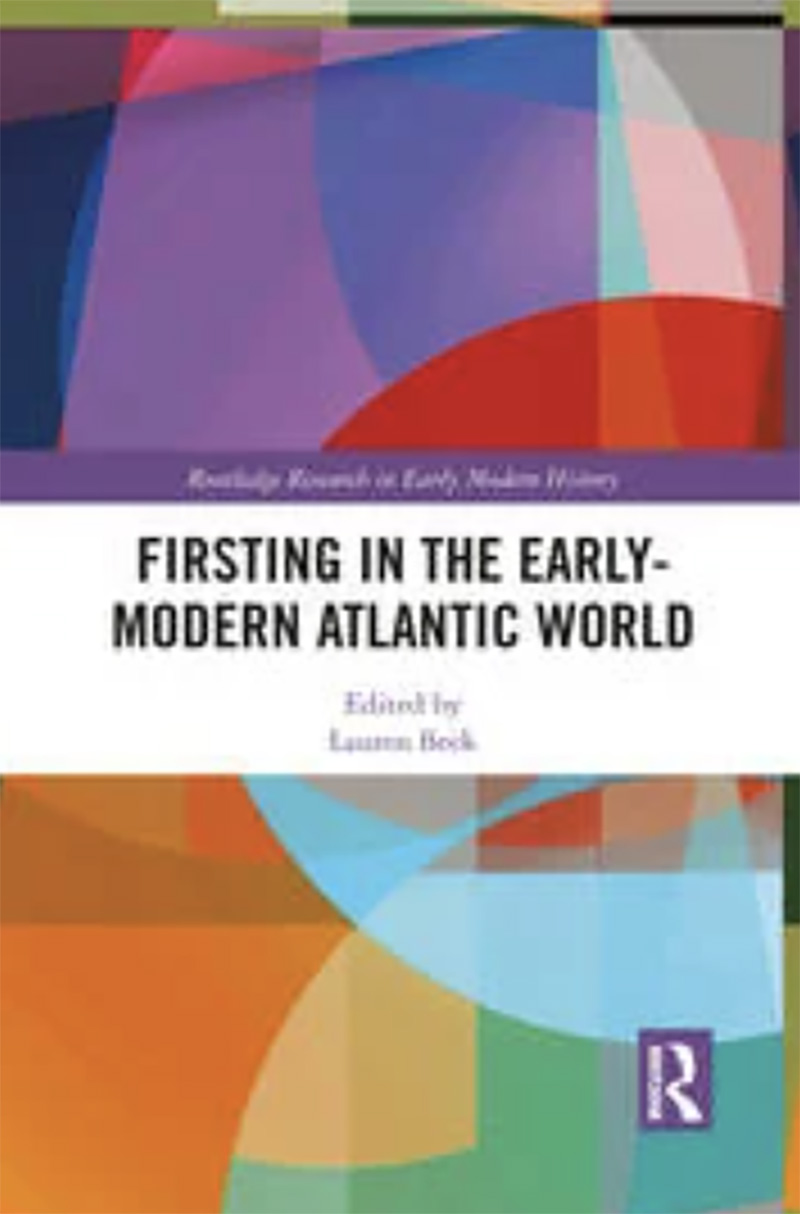 For centuries, historians have narrated the arrival of Europeans using terminology (discovery, invasion, conquest, and colonization) that emphasizes their agency and disempowers that of Native Americans.
For centuries, historians have narrated the arrival of Europeans using terminology (discovery, invasion, conquest, and colonization) that emphasizes their agency and disempowers that of Native Americans.
This book explores firsting, a discourse that privileges European and settler-colonial presence, movements, knowledges, and experiences as a technology of colonization in the early modern Atlantic world, 1492-1900. It exposes how textual culture has ensured that Euro-settlers dominate Native Americans, while detailing misrepresentations of Indigenous peoples as unmodern and proposing how the western world can be un-firsted in scholarship on this time and place. - Publisher's Description
Request this Title
The Maya: Lost Civilizations
O'Neil, Megan (2022)
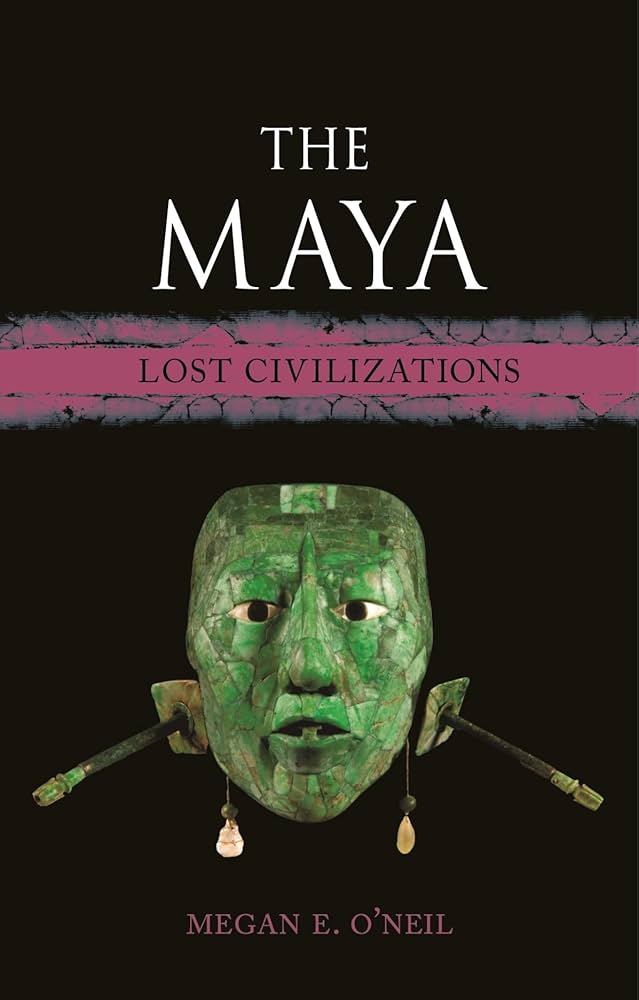 This book reveals how the ancient Maya—and their buildings, ideas, objects, and identities—have been perceived, portrayed, and exploited over five hundred years in the Americas, Europe, and beyond.
This book reveals how the ancient Maya—and their buildings, ideas, objects, and identities—have been perceived, portrayed, and exploited over five hundred years in the Americas, Europe, and beyond.
Engaging in interdisciplinary analysis, the book summarizes ancient Maya art and history from the preclassical period to the Spanish invasion, as well as the history of outside engagement with the ancient Maya, from Spanish invaders in the sixteenth century to later explorers and archaeologists, taking in scientific literature, visual arts, architecture, world’s fairs, and Indigenous activism. It also looks at the decipherment of Maya inscriptions, Maya museum exhibitions and artists’ responses, and contemporary Maya people’s engagements with their ancestral past. Featuring the latest research, this book will interest scholars as well as general readers who wish to know more about this ancient, fascinating culture. - Publisher's Description
Request this Title
The Indigenous Paradox: Rights, Sovereignty, and Culture in the Americas
Bens, Jonas (2020)
 In the twenty-first century, it is politically and legally commonplace that indigenous communities go to court to assert their rights against the postcolonial nation-state in which they reside. But upon closer examination, this constellation is far from straightforward. Indigenous communities make their claims as independent entities, governed by their own laws. And yet, they bring a case before the court of another sovereign, subjecting themselves to its foreign rule of law.
In the twenty-first century, it is politically and legally commonplace that indigenous communities go to court to assert their rights against the postcolonial nation-state in which they reside. But upon closer examination, this constellation is far from straightforward. Indigenous communities make their claims as independent entities, governed by their own laws. And yet, they bring a case before the court of another sovereign, subjecting themselves to its foreign rule of law.
According to Jonas Bens, when native communities enter into legal relationships with postcolonial nation-states, they "become indigenous." Indigenous communities define themselves as separated from the settler nation-state and insist that their rights originate from within their own system of laws. At the same time, indigenous communities must argue that they are incorporated in the settler nation-state to be able to use its judiciary to enforce these rights. As such, they are simultaneously included into and excluded from the state.
Tracing how the indigenous paradox is inscribed into the law by investigating several indigenous rights cases in the Americas, from the early nineteenth century to the early twenty-first, Bens illustrates how indigenous communities have managed—and continue to manage—to navigate this paradox by developing lines of legal reasoning that mobilize the concepts of sovereignty and culture. Bens argues that understanding indigeneity as a paradoxical formation sheds light on pressing questions concerning the role of legal pluralism and shared sovereignty in contemporary multicultural societies. - Publisher's Description
Request this Title
Alaska: An American Colony
Haycox, Stephen (2020)
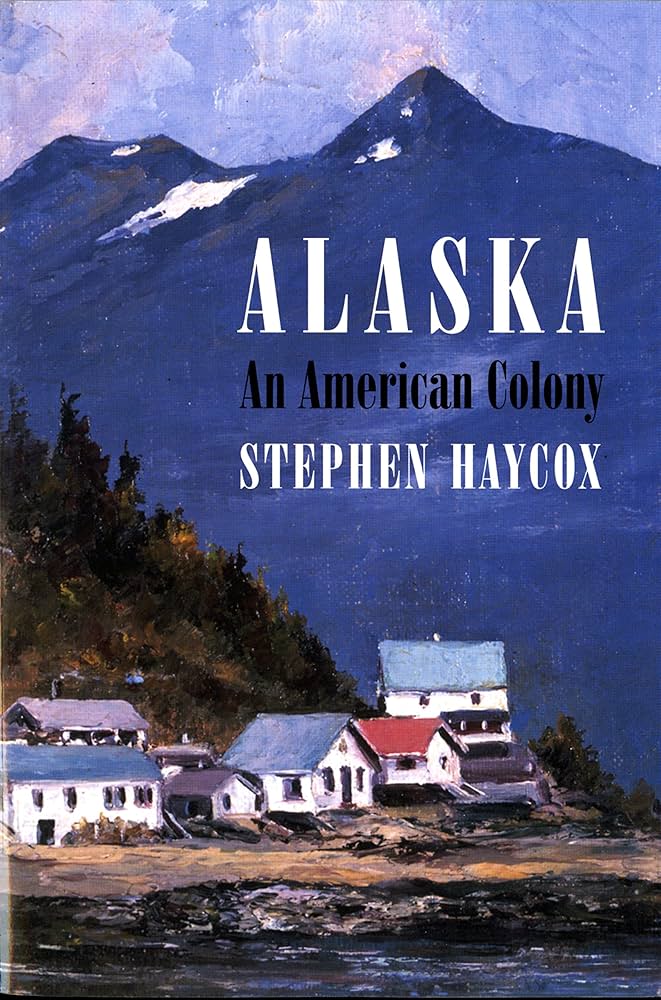 Alaska has not evolved in a vacuum. It has been part of larger stories: the movement of Native peoples and their contact and accommodation to Western culture, the spread of European political economy to the New World, and the expansion of American capitalism and culture.
Alaska has not evolved in a vacuum. It has been part of larger stories: the movement of Native peoples and their contact and accommodation to Western culture, the spread of European political economy to the New World, and the expansion of American capitalism and culture.
Alaska, an American Colony focuses on Russian America and American Alaska, bringing the story of Alaska up to the present and exploring the continuing impact of Alaska Native claims settlements, the trans-Alaska pipeline, and the Alaska Lands Act. In contrast to the stereotype of Alaska as a place where rugged individualists triumph over the harsh environment, distinguished historian Stephen Haycox offers a less romantic, more complex history that emphasizes the broader national and international contexts of Alaska’s past and the similarities between Alaska and the American West. Covering cultural, political, economic, and environmental history, the book also includes an overview of the region’s geography and the anthropology of Alaska’s Native peoples.
Throughout "Alaska, an American Colony," Haycox stresses the continuing involvement of Alaska Natives in the state’s economic, political, and social life and development. He also explores the power of myth in historical representations of Alaska and the controlling influence of national perceptions of the region. - Publisher's Description
Request this Title
An Indigenous Peoples' History of the United States
Dunbar-Ortiz, Roxanne (2015)
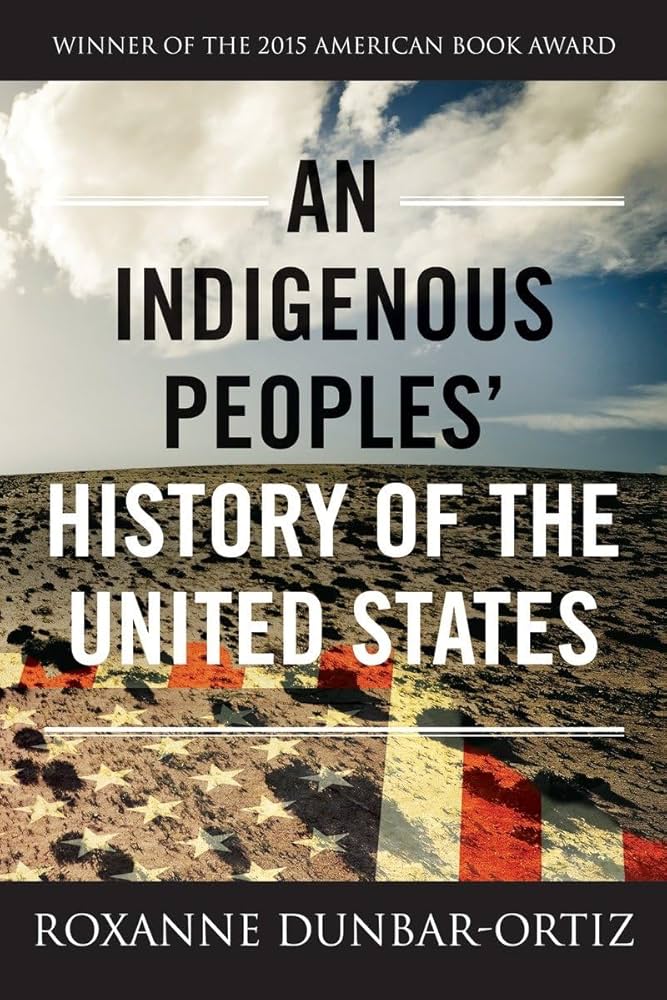 Today in the United States, there are more than five hundred federally recognized Indigenous nations comprising nearly three million people, descendants of the fifteen million Native people who once inhabited this land. The centuries-long genocidal program of the US settler-colonial regimen has largely been omitted from history. Now, for the first time, acclaimed historian and activist Roxanne Dunbar-Ortizoffers a history of the United States told from the perspective of Indigenous peoples and reveals how Native Americans, for centuries, actively resisted expansion of the US empire.
Today in the United States, there are more than five hundred federally recognized Indigenous nations comprising nearly three million people, descendants of the fifteen million Native people who once inhabited this land. The centuries-long genocidal program of the US settler-colonial regimen has largely been omitted from history. Now, for the first time, acclaimed historian and activist Roxanne Dunbar-Ortizoffers a history of the United States told from the perspective of Indigenous peoples and reveals how Native Americans, for centuries, actively resisted expansion of the US empire.
With growing support for movements such as the campaign to abolish Columbus Day and replace it with Indigenous Peoples’ Day and the Dakota Access Pipeline protest led by the Standing Rock Sioux Tribe, "An Indigenous Peoples’ History of the United States" is an essential resource providing historical threads that are crucial for understanding the present. In "An Indigenous Peoples’ History of the United States," Dunbar-Ortiz adroitly challenges the founding myth of the United States and shows how policy against the Indigenous peoples was colonialist and designed to seize the territories of the original inhabitants, displacing or eliminating them. And as Dunbar-Ortiz reveals, this policy was praised in popular culture, through writers like James Fenimore Cooper and Walt Whitman, and in the highest offices of government and the military. Shockingly, as the genocidal policy reached its zenith under President Andrew Jackson, its ruthlessness was best articulated by US Army general Thomas S. Jesup, who, in 1836, wrote of the Seminoles: “The country can be rid of them only by exterminating them.”
Spanning more than four hundred years, this classic bottom-up peoples’ history radically reframes US history and explodes the silences that have haunted our national narrative.
"An Indigenous Peoples' History of the United States" is a 2015 PEN Oakland-Josephine Miles Award for Excellence in Literature. - Publisher's Description
Request this Title
Time of Anarchy: Indigenous Power and the Crisis of Colonialism in Early America
Kruer, Matthew (2022)
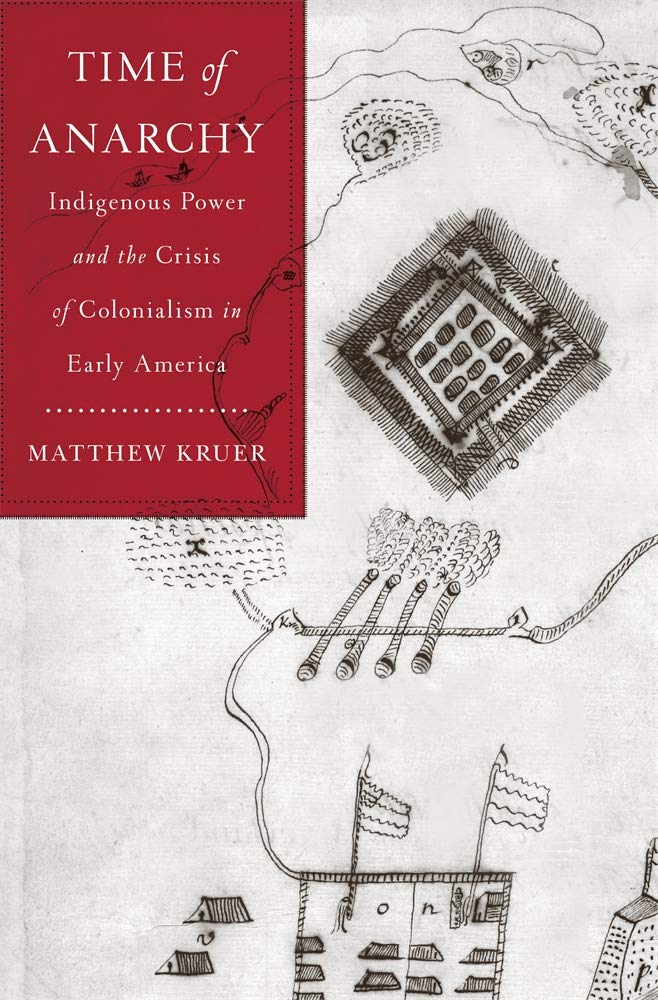 In 1675, eastern North America descended into chaos. Virginia exploded into civil war, as rebel colonists decried the corruption of planter oligarchs and massacred allied Indians. Maryland colonists, gripped by fears that Catholics were conspiring with enemy Indians, rose up against their rulers. Separatist movements and ethnic riots swept through New York and New Jersey. Dissidents in northern Carolina launched a revolution, proclaiming themselves independent of any authority but their own. English America teetered on the edge of anarchy.
In 1675, eastern North America descended into chaos. Virginia exploded into civil war, as rebel colonists decried the corruption of planter oligarchs and massacred allied Indians. Maryland colonists, gripped by fears that Catholics were conspiring with enemy Indians, rose up against their rulers. Separatist movements and ethnic riots swept through New York and New Jersey. Dissidents in northern Carolina launched a revolution, proclaiming themselves independent of any authority but their own. English America teetered on the edge of anarchy.
Though seemingly distinct, these conflicts were in fact connected through the Susquehannock Indians, a once-mighty nation reduced to a small remnant. Forced to scatter by colonial militia, Susquehannock bands called upon connections with Indigenous nations from the Great Lakes to the Deep South, mobilizing sources of power that colonists could barely perceive, much less understand. Although the Susquehannock nation seemed weak and divided, it exercised influence wildly disproportionate to its size, often tipping settler societies into chaos. Colonial anarchy was intertwined with Indigenous power.
Piecing together Susquehannock strategies from a wide range of archival documents and material evidence, Matthew Kruer shows how one people’s struggle for survival and renewal changed the shape of eastern North America. Susquehannock actions rocked the foundations of the fledging English territories, forcing colonial societies and governments to respond. "Time of Anarchy" recasts our understanding of the late seventeenth century and places Indigenous power at the heart of the story. - Publisher's Description
Request this Title
Digital Mapping and Indigenous America
Hess, Janet Berry (2021)
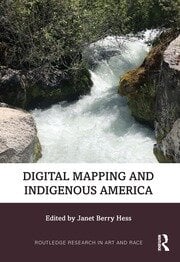 Employing anthropology, field research, and humanities methodologies as well as digital cartography, and foregrounding the voices of Indigenous scholars, this text examines digital projects currently underway, and includes alternative modes of "mapping" Native American, Alaskan Native, Indigenous Hawaiian and First Nations land. The work of both established and emerging scholars addressing a range of geographic regions and cultural issues is also represented. Issues addressed include the history of maps made by Native Americans; healing and reconciliation projects related to boarding schools; language and land reclamation; Western cartographic maps created in collaboration with Indigenous nations; and digital resources that combine maps with narrative, art, and film, along with chapters on archaeology, place naming, and the digital presence of elders.
Employing anthropology, field research, and humanities methodologies as well as digital cartography, and foregrounding the voices of Indigenous scholars, this text examines digital projects currently underway, and includes alternative modes of "mapping" Native American, Alaskan Native, Indigenous Hawaiian and First Nations land. The work of both established and emerging scholars addressing a range of geographic regions and cultural issues is also represented. Issues addressed include the history of maps made by Native Americans; healing and reconciliation projects related to boarding schools; language and land reclamation; Western cartographic maps created in collaboration with Indigenous nations; and digital resources that combine maps with narrative, art, and film, along with chapters on archaeology, place naming, and the digital presence of elders.
This text is of interest to scholars working in history, cultural studies, anthropology, Native American studies, and digital cartography. - Publisher's Description
Request this Title
Natural Science and Indigenous Knowledge: The Americas Experience
Johnson, Edward; Arlidge, Susan (2024)
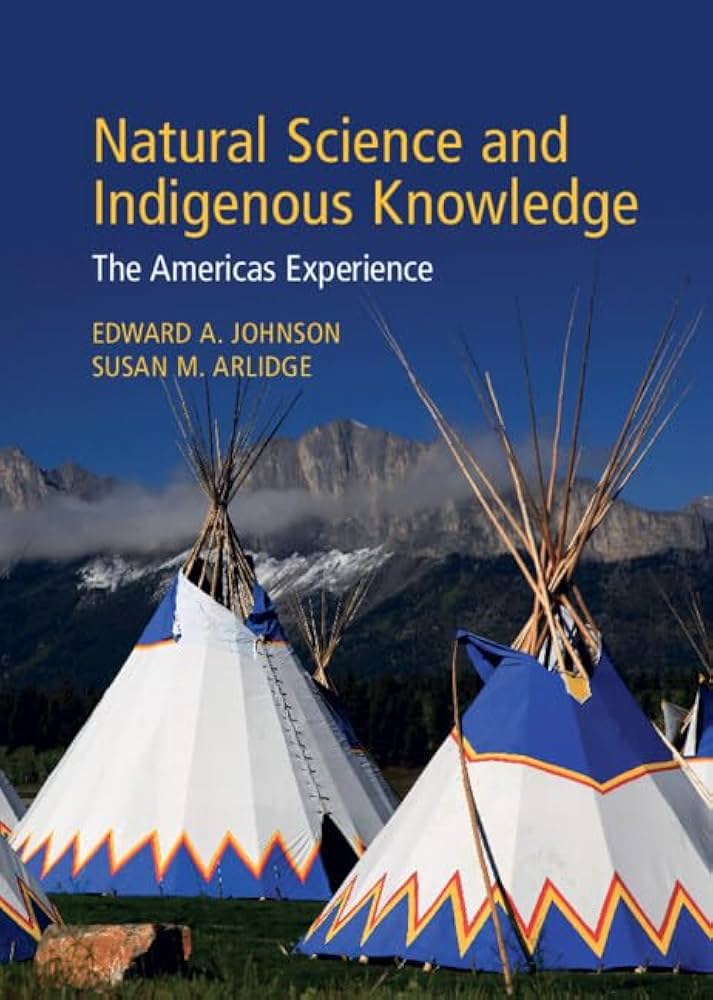 How do we combine the areas of intersection between science and indigenous knowledge, but without losing the totality of both? This book's objective is to consider how Indigenous populations have lived and managed the landscape. Specifically, how their footprint was a result of the combination of their empirical knowledge and their culture.
How do we combine the areas of intersection between science and indigenous knowledge, but without losing the totality of both? This book's objective is to consider how Indigenous populations have lived and managed the landscape. Specifically, how their footprint was a result of the combination of their empirical knowledge and their culture.
The chapters are divided into four groups: The first deals with reintegrating cultures and natural landscapes and the role of kinship and oral tradition. The second group approaches the landscape as a living university of learning and managing, discussing the ethnobotany of how to grow more responsibly, and assess and project the harvest. The third group deals with the managing of fire in an anthropogenic plant community and how to integrate indigenous agriculture in hydrology and dry regions. The fourth group consists of studies of how science and indigenous knowledge can be taught in schools using land-based studies. - Publisher's Description
Request this Title
From the Boarding Schools: Apache Indian Students Speak
Krupat, Arnold (2023)
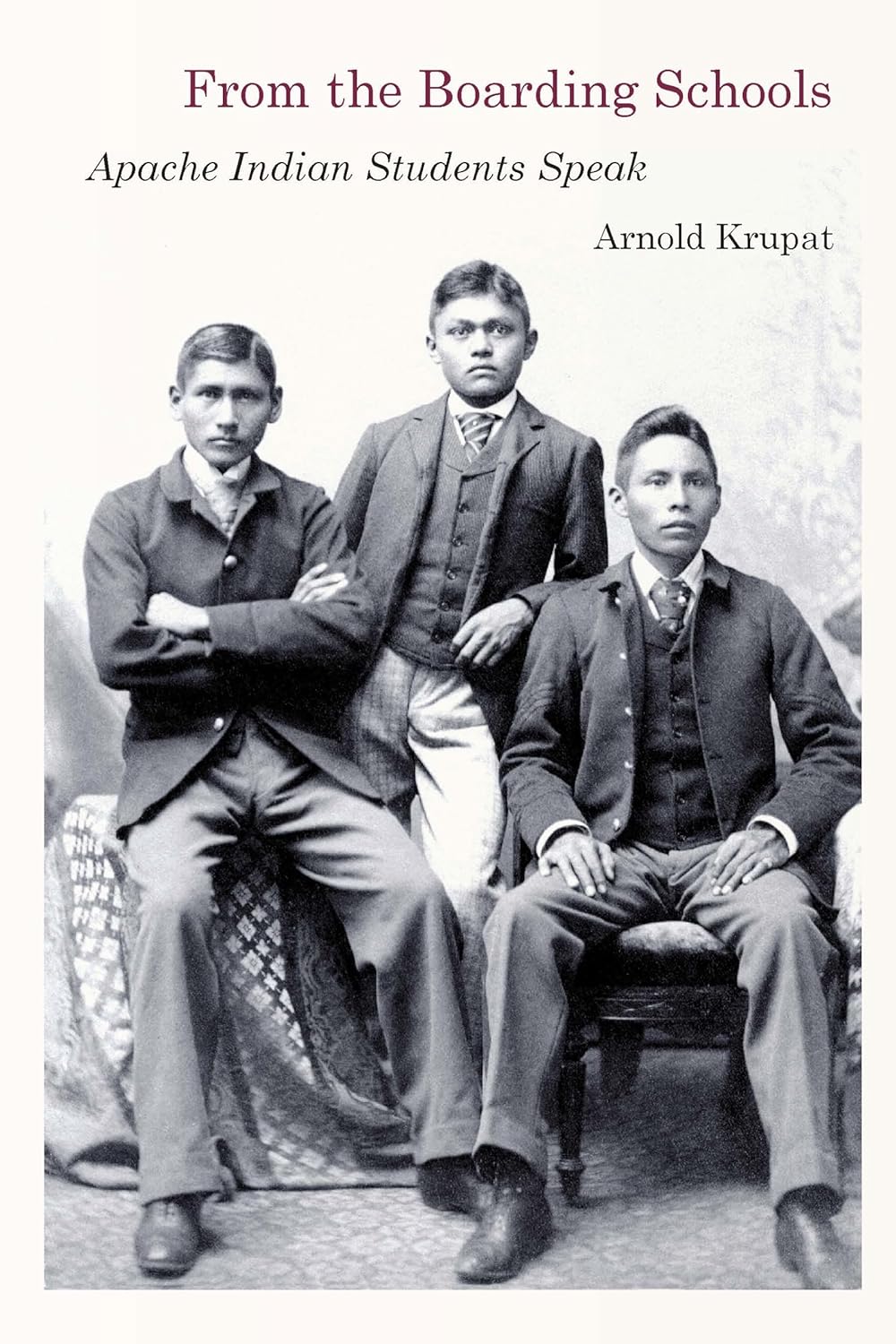 Arnold Krupat’s "From the Boarding Schools" makes available previously unheard Apache voices from the Indian boarding schools. It includes selections from two unpublished autobiographies by Sam Kenoi and Dan Nicholas, produced in the 1930s with the anthropologist Morris Opler, as well as material by and about Vincent Natalish, a contemporary of Kenoi and Nicholas.
Arnold Krupat’s "From the Boarding Schools" makes available previously unheard Apache voices from the Indian boarding schools. It includes selections from two unpublished autobiographies by Sam Kenoi and Dan Nicholas, produced in the 1930s with the anthropologist Morris Opler, as well as material by and about Vincent Natalish, a contemporary of Kenoi and Nicholas.
Natalish was one of more than one hundred Apaches taken from Fort Marion to the Carlisle Indian School by its superintendent, Captain Richard Henry Pratt, in 1887. A considerable number of these students died at the school, and many who were sent home for illness or poor health did not recover. Natalish, however, remained at Carlisle and graduated in 1899. He married, had a son, and lived and worked in New York. He also actively sought the release of his relatives and other Apaches held prisoner at Fort Sill, Oklahoma.
Apache people have been telling and circulating stories among themselves for generations. But in contrast to their neighbors the Hopis and the Navajos, Apaches have produced relatively few written autobiographical narratives, and even fewer about their boarding school experiences. Supplementing the narratives with detailed cultural and historical commentary, "From the Boarding Schools" brings these lived experiences from the archives into current discourse. - Publisher's Description
Request this Title
Indian Spectacle: College Mascots and the Anxiety of Modern America
Guiliano, Jennifer (2015)
 Amid controversies surrounding the team mascot and brand of the Washington Redskins in the National Football League and the use of mascots by K–12 schools, Americans demonstrate an expanding sensitivity to the pejorative use of references to Native Americans by sports organizations at all levels. In "Indian Spectacle," Jennifer Guiliano exposes the anxiety of American middle-class masculinity in relation to the growing commercialization of collegiate sports and the indiscriminate use of Indian identity as mascots.
Amid controversies surrounding the team mascot and brand of the Washington Redskins in the National Football League and the use of mascots by K–12 schools, Americans demonstrate an expanding sensitivity to the pejorative use of references to Native Americans by sports organizations at all levels. In "Indian Spectacle," Jennifer Guiliano exposes the anxiety of American middle-class masculinity in relation to the growing commercialization of collegiate sports and the indiscriminate use of Indian identity as mascots.
"Indian Spectacle" explores the ways in which white, middle-class Americans have consumed narratives of masculinity, race, and collegiate athletics through the lens of Indian-themed athletic identities, mascots, and music. Drawing on a cross-section of American institutions of higher education, Guiliano investigates the role of sports mascots in the big business of twentieth-century American college football in order to connect mascotry to expressions of community identity, individual belonging, stereotyped imagery, and cultural hegemony.
Against a backdrop of the current level of the commercialization of collegiate sports—where the collective revenue of the fifteen highest grossing teams in Division I of the National Collegiate Athletic Association (NCAA) has well surpassed one billion dollars—Guiliano recounts the history of the creation and spread of mascots and university identities as something bound up in the spectacle of halftime performance, the growth of collegiate competition, the influence of mass media, and how athletes, coaches, band members, spectators, university alumni, faculty, and administrators, artists, writers, and members of local communities all have contributed to the dissemination of ideas of Indianness that is rarely rooted in native people’s actual lives. - Publisher's Description
Request this Title
